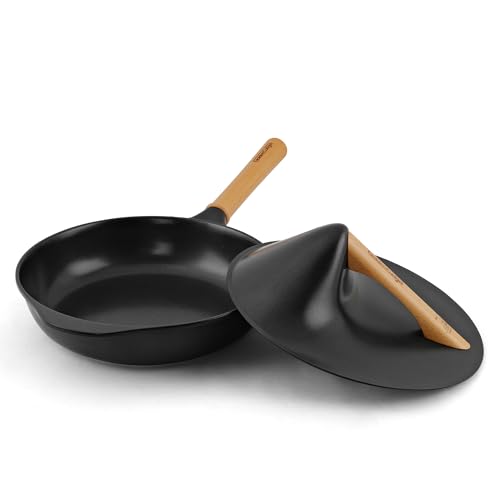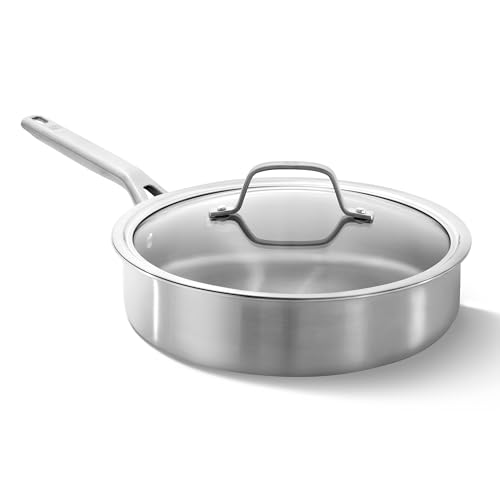In our test kitchen, there are a few tools that earn the title of “indispensable,” and a large, high-quality sauté pan is chief among them. It’s the vessel where so many incredible meals begin. It’s for searing pork chops to a perfect golden-brown crust, for slowly coaxing the sweetness out of a mountain of onions for French onion soup, and for building a rich, flavorful pan sauce that ties an entire dish together. The problem is finding one that truly does it all without compromise. Too many pans promise even heating but deliver frustrating hot spots. Others look professional but can’t stand up to the high heat of a good sear, warping into a wobbly, unusable state. This quest for a reliable, capacious, and versatile pan is what led us to test the Cuisinart MCP33-30HN MultiClad Pro 5.5-Quart Sauté Pan, a piece of cookware that, on paper, seems to tick every single box for the serious home cook.
- EXCEPTIONAL DESIGN: Enjoy mirror finish, classic look and professional performance. Aluminum encapsulated base heats quickly and...
- PREMIUM COOKING: Constructed to last. Drip-free pouring– Flavor Lock Lid
What to Consider Before Buying a Sauté Pan
A sauté pan is more than just an item; it’s a key solution for achieving professional-level results at home. Its wide, flat base is ideal for maximizing contact with the heat source, ensuring a deep, even sear on proteins. The straight, high sides are designed to contain splatters during frying and hold significant volumes of liquid for braises and sauces, making it far more versatile than a traditional skillet. The main benefits are control, capacity, and versatility. Without a good one, you risk steaming your food instead of searing it, crowding ingredients which leads to uneven cooking, and struggling to build complex dishes in a single vessel. A great sauté pan is the bridge between a good home cook and a great one.
The ideal customer for this type of product is someone who frequently cooks for a family or enjoys batch cooking. They need the capacity to sear multiple chicken thighs at once or reduce a large amount of stock without it boiling over. They appreciate the versatility of a pan that can go from stovetop to a 550°F oven. However, it might not be suitable for those with limited storage space, as a 5.5-quart pan is substantial. It’s also not for the cook who exclusively wants a “set it and forget it” nonstick experience; stainless steel requires a bit more technique to master. For those users, a smaller pan or a dedicated nonstick skillet might be a better starting point.
Before investing, consider these crucial points in detail:
- Dimensions & Space: A 5.5-quart pan typically has a diameter of 12 inches or more. You must ensure your cooktop can accommodate this size without crowding other burners. Consider its weight, especially when full, and the length of its handle for storage in cabinets or your oven. The addition of a helper handle, like the one on this Cuisinart, is a critical ergonomic feature for safely moving a heavy pan.
- Capacity/Performance: Capacity isn’t just about volume; it’s about surface area. A wide base allows you to cook food in a single layer, which is essential for browning. Performance hinges on heat conductivity and retention. A pan that heats evenly prevents scorching in one spot while another remains undercooked, a crucial factor for delicate sauces and searing.
- Materials & Durability: This is arguably the most important factor. Tri-ply construction, featuring an aluminum core sandwiched between layers of stainless steel, is the gold standard for blending durability with excellent, even heating. Cheaper pans use a simple aluminum disc bonded to the bottom, which is less effective and can sometimes separate. The quality of the steel and the riveting of the handles are key indicators of a pan’s long-term durability and whether it can truly last a lifetime.
- Ease of Use & Maintenance: Is the pan balanced? Are the handles comfortable and do they stay cool? Is the lid tight-fitting to lock in moisture? While many stainless steel pans are technically dishwasher safe, hand washing is often recommended to maintain their luster. You should also be prepared to learn the proper techniques for heating and oiling to prevent food from sticking.
Ultimately, choosing the right sauté pan is a foundational decision for your kitchen. Getting it right means years of happy cooking, while getting it wrong leads to endless frustration.
While the Cuisinart MCP33-30HN MultiClad Pro 5.5-Quart Sauté Pan is an interesting contender, it’s always wise to see how it stacks up against the competition. For a broader look at all the top models, including different materials and sizes, we highly recommend checking out our complete, in-depth guide:
- HEALTHY SKILLET - Switzerland ILAG nonstick surface. Free of PFOA, PFOS, lead, cadmium and other toxic materials that can leach into...
- Premium 12-inch stainless steel fry pan with a lid, featuring a durable and versatile tri-ply construction for even heat distribution...
- NON-TOXIC CERAMIC COATING: Goldencudgel deep saute pan with stay cool handle features premium Alumium and natural ceramic coating free...
First Impressions: A Promising Start with a Few Red Flags
Unboxing the Cuisinart MCP33-30HN MultiClad Pro 5.5-Quart Sauté Pan, our initial reaction was mixed. The mirror-finish stainless steel is classic and looks the part of a professional kitchen tool. The sheer size is impressive; the 5.5-quart capacity promises the ability to handle large-format meals with ease. The main handle is long and feels reasonably comfortable, and the inclusion of a helper handle is a non-negotiable feature at this size, which we were glad to see. The lid fits snugly, a good sign for its “Flavor Lock” claims.
However, as we handled it, a few subtle things gave us pause, echoing sentiments from other users. Compared to premium brands like All-Clad or even heavier-duty commercial pans, the Cuisinart felt surprisingly light for its size. One user noted their smaller Fissler pan was heavier, and we can understand that perception. The pan’s body and lid don’t have the same dense, bomb-proof heft. This isn’t necessarily a deal-breaker—lighter weight can be an ergonomic plus—but in cookware, heft often correlates with heat retention and resistance to warping. It left us with a lingering question: could a pan this light truly withstand the rigors of high-heat cooking and earn its “Pro” moniker? We were eager to find out.
What We Like
- Generous Capacity: The 5.5-quart size is fantastic for large families, batch cooking, and one-pan meals.
- Excellent Versatility: Oven safe up to 550°F and compatible with all cooktops, including induction.
- Ergonomic Handles: The combination of a long main handle and a helper handle makes it manageable even when full.
- Affordable Price Point: Offers the features of a high-end tri-ply pan at a significantly lower cost.
Drawbacks
- Significant Warping Issues: The base is highly prone to bulging and becoming convex, rendering it ineffective on flat cooktops.
- Inconsistent Quality Control: Reports of cosmetic defects and a flimsy feel suggest manufacturing standards are lacking.
In-Depth Performance Analysis: Where Promise Meets a Troubling Reality
A sauté pan lives or dies by its performance on the stove. It must heat evenly, hold that heat, and most importantly, remain flat. Our extensive testing of the Cuisinart MCP33-30HN MultiClad Pro 5.5-Quart Sauté Pan revealed a product with a deep, fundamental conflict between its design theory and its real-world execution.
Design, Capacity, and Ergonomics
From a pure design perspective, the pan’s blueprint is solid. The 12-inch diameter cooking surface is a dream for searing. We could easily fit four large chicken breasts or six pork chops without crowding, allowing for a beautiful, even crust to develop. The high, straight sides did an admirable job of containing oil splatter when shallow frying and held a full batch of bolognese sauce with room to spare. This is where the 5.5-quart capacity truly shines, making it a genuine workhorse for big cooking projects. We found the combination of the long “Cool Grip” handle and the riveted helper handle to be essential. Moving the pan from the stovetop to the oven, even when laden with a heavy braise, felt secure and balanced. The drip-free pouring rim also worked as advertised, a small but appreciated detail when transferring sauces.
However, the praise for the design is consistently undermined by the feel of the materials. That initial impression of lightness never went away. The stainless steel, while polished and attractive, simply lacks the reassuring density of its premium competitors. The lid, in particular, feels thin and insubstantial. While it fits well, it doesn’t have the weight to create the heavy, tight seal you’d find on a Dutch oven or a higher-end sauté pan. For slow braises, this could mean more moisture evaporation than desired. The ergonomics are good, but the underlying build quality leaves you wondering about its long-term resilience, a concern that would prove to be well-founded.
The Heart of the Matter: Heating Performance and the Warping Failure
This is where our review takes a sharp, unfortunate turn. The entire purpose of Cuisinart’s MultiClad Pro line is its tri-ply construction—an aluminum core for rapid, even heating, clad in durable stainless steel. In theory, this should eliminate hot spots and provide superior cooking control. And for the very first use, on medium heat, it performed reasonably well. It heated up faster than a cast iron pan and seemed to distribute the heat across its wide base.
The problem arose, catastrophically, when we subjected it to the kind of heat a “Pro” pan is built for. When searing beef for a stew over medium-high heat on our glass cooktop, we heard a faint but distinct ‘ping’. After cooling, the pan was no longer flat. The center of the base had bulged outward, creating a convex bottom. When placed on a flat surface, the pan spun like a top. This is the exact issue cited by a staggering number of users. One reviewer described it perfectly: “The center bulges outward so you can spin the pan on a table.” We experienced the same critical failure. This warping is not a minor inconvenience; it’s a fatal flaw for anyone with an electric, ceramic, or induction cooktop. The lack of flat contact means the pan no longer heats efficiently or evenly. Heat is concentrated on the tiny ring of the base still touching the cooktop, while the majority of the pan’s surface relies on poor heat conduction through an air gap. This completely negates the benefit of the tri-ply construction. Cooking becomes a nightmare of scorching and uneven results, precisely what the pan is supposed to prevent.
Quality Control and Authenticity Concerns
The warping issue points to a larger problem that pervades this product: a severe lack of quality control. A well-constructed tri-ply pan should not warp under normal household cooking temperatures, especially one rated for 550°F in the oven. The fact that this happens so frequently—often on the very first use—suggests issues with the materials, the bonding process, or the overall manufacturing standard. This observation is strongly supported by other user experiences. We saw reports of pans arriving with carbon spots, defects in the steel, and even incomplete engravings on the bottom, with one user noting text that read “STAINLESS STE” and “INDUCTION REA.”
These are not the hallmarks of a premium product. They suggest a production line that is either cutting corners or failing to implement basic quality checks. When you buy a product with “Pro” in the name from a legacy brand like Cuisinart, you expect a certain baseline of reliability. Many long-time Cuisinart customers expressed similar shock, with one stating, “I’ve had Cuisinart pans since 1987 and this is the first and only pan that warped.” This consistent pattern of defects forces us to question whether the Cuisinart brand’s reputation for quality still applies to this specific product line. It’s a roll of the dice, and the odds don’t seem to be in the consumer’s favor. If you’re still intrigued by its potential, you can see its full feature set and user reviews, but we advise proceeding with extreme caution.
What Other Users Are Saying
Our findings are far from isolated; they represent a clear and consistent pattern in user feedback. While a single positive review mentions that the pan is “a pleasure to use” with “great” heat transfer, this experience appears to be the exception rather than the rule. The overwhelming majority of detailed feedback aligns with our negative experience.
The most prevalent complaint, by a wide margin, is warping. One user lamented, “Within two weeks, the pan warped and now has little contact with our flat induction cooktop.” Another stated, “Very disappointed that the bottom of this pan became rounded within less than one year.” This isn’t just an aesthetic issue; it renders the pan nearly useless on flat cooking surfaces. The sentiment of poor quality is also a common theme. Comments like “does not have a quality feel, mainly because of the weight” and “Surprisingly poor quality control for something that has ‘pro’ in the name” are frequent. These reports, combined with frustrating customer service experiences from users who tried to utilize the warranty, paint a picture of a product that fails to live up to both its name and its brand’s legacy.
Comparing the Cuisinart MCP33-30HN to Top Alternatives
Given the significant performance issues with the Cuisinart pan, it’s essential to consider more reliable alternatives. The market offers several compelling options at different price points and with different feature sets. Here’s how the Cuisinart MCP33-30HN MultiClad Pro 5.5-Quart Sauté Pan stacks up against three leading competitors.
1. Calphalon Stainless Steel 3-Qt Sauté Pan
- Non-Toxic Stainless Steel: Built with durable 3-layer construction for lasting performance
- Calphalon Turbo Temp Technology: Heats up to 30% faster*, so you can get cooking faster (*Calphalon Stainless Steel vs. Cuisinart...
The Calphalon Stainless Steel 3-Qt Sauté Pan represents a more compact and arguably more reliable choice for smaller households or kitchens. With a 3-quart capacity, it’s not designed for the same large-format cooking as the Cuisinart, but what it lacks in size, it often makes up for in consistent quality. Calphalon has a strong reputation for durable, impact-bonded aluminum bases that are resistant to warping. This is an ideal choice for a couple or small family who wants the benefits of a stainless steel sauté pan for searing and sauce-making but doesn’t need the massive 5.5-quart volume. If reliability is your top priority over sheer size, the Calphalon is a much safer bet.
2. All-Clad D3 3-Quart Sauté Pan
- Enhance your cooking capabilities with this 3 quart stainless steel sauté pan, featuring All-Clad's D3 tri-ply construction for...
- Fast and Even Heat - D3 tri-ply is fully bonded to the rim for professional performance & durability. The high quality 18/10 stainless...
The All-Clad D3 is the undisputed gold standard to which all other stainless steel cookware is compared. While also smaller at 3 quarts, its performance is in a completely different league. Made in the USA, All-Clad’s D3 line features impeccable tri-ply bonding that extends all the way up the sides of the pan, providing incredibly even heating without any risk of warping. The build quality is exceptional, designed to literally last a lifetime. Of course, this performance comes at a premium price. For serious cooks who are willing to invest in a “buy it for life” piece of equipment and are willing to forgo the larger capacity, the All-Clad D3 is the superior choice in every performance metric.
3. Caraway 4.5 qt Nonstick Sauté Pan
- CARAWAY NOW LIVE ON AMAZON: Caraway has officially launched their best-selling and consciously crafted cookware on Amazon for everyone...
- 11.8” SAUTE PAN: Your new best friend for dinner parties, dishes with stock, stir fries and more. This durable non-stick pan makes...
For those turned off by the potential for food sticking in stainless steel or disillusioned by the Cuisinart’s quality issues, the Caraway Nonstick Ceramic Sauté Pan offers a completely different path. With a generous 4.5-quart capacity, it still handles large meals well. Its primary selling point is its non-toxic ceramic nonstick coating, which provides effortless food release and easy cleanup without PTFE or PFOA. While it won’t produce the same hard sear as stainless steel and requires more care to protect the coating, it’s a fantastic option for home cooks who prioritize convenience, health-conscious materials, and aesthetics. It’s the perfect alternative for someone who wants versatility without the learning curve of traditional stainless cookware.
Final Verdict: A Disappointing Misfire from a Trusted Brand
The Cuisinart MCP33-30HN MultiClad Pro 5.5-Quart Sauté Pan is a product we desperately wanted to love. On paper, it offers the perfect combination of size, versatility, and features at an accessible price. Its generous capacity is a true asset, and the ergonomic design with the helper handle is well-conceived. Unfortunately, these positive attributes are completely overshadowed by a critical and widespread manufacturing flaw: the base’s propensity to warp under normal cooking heat. This defect renders it ineffective and deeply frustrating to use on any modern flat cooktop.
When combined with numerous reports of poor quality control, we simply cannot recommend this pan. The risk of receiving a defective unit is far too high. While you might get lucky and receive one that performs as intended, it’s a gamble we don’t advise taking. We recommend investing in a more reliable alternative, such as the premium All-Clad for lifetime performance or the Caraway for nonstick convenience. It is with disappointment that we conclude our review; this pan promises professional results but, for too many users, fails to deliver even the basics. If, after weighing all the risks, you still wish to check the latest price and availability, we urge you to test it immediately on a flat surface upon arrival.
Last update on 2025-11-07 / Affiliate links / Images from Amazon Product Advertising API







